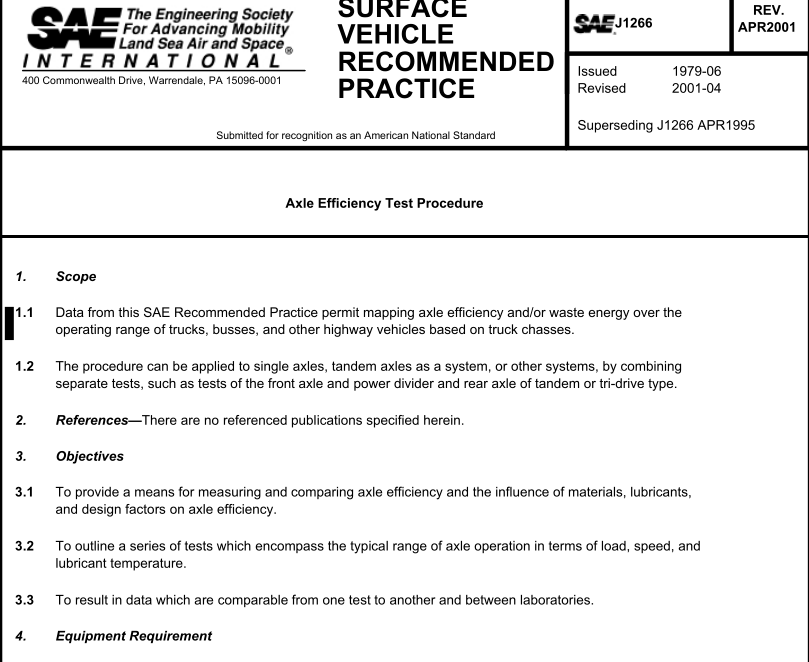SAE J1266:2001 pdf download Axle Efficiency Test Procedure
Data from this SAE Recommended Practice permit mapping axle efficiency and/or waste energy over theoperating range of trucks, busses, and other highway vehicles based on truck chasses.
1.2 The procedure can be applied to single axles, tandem axles as a system, or other systems, by combining separate tests, such as tests of the front axle and power divider and rear axle of tandem or tri-drive type.
2.References—There are no referenced publications specified herein.
3.Objectives
3.1 To provide a means for measuring and comparing axle efficiency and the influence of materials, lubricants,and design factors on axle efficiency.
3.2To outline a series of tests which encompass the typical range of axle operation in terms of load, speed, and lubricant temperature.
3.3To result in data which are comparable from one test to another and between laboratories.
4.Equipment Requirement
4.1 An axle dynamometer with torque and speed capabilities consistent with the size axle being tested.Separate absorbers for each output are preferred.
4.2A separate test stand without absorbers for the no-load portion of the test is optional.
4.3 Capability of measuring input speed with an accuracy of ±1% of the actual speed.
4.4Capability of measuring all torques specified with an accuracy of +0.5% of the actual torque.
4.5Means for measuring and controlling sump lubricant temperatures to ±6.0 °C for steady-state temperature test sequences.
4.6Means for cold soaking the axle assembly to-35 -C when efficiency at low temperature is to be measured.
5.Test Preparation
The test axle is to be representative of the particular axle design.Setting of bearing preloads, backlash, etc.,outside of design specification limits is permissible only if that is the purpose of the test. This applies to production and experimental designs.
5.2To preclude differential gear rotation as a source of inefficiency, all differentials are to be locked or mechanically blocked from rotating.
NOTE—Some dynamometers with automatic feedback systems to control relative speeds of absorbers may require deactivation of the feedback system.
5.3The axle is to be equipped to measure sump temperature.
5.4 The axle assembly is to be tested at the attitude in which it would be installed in a vehicle, unless otherwise specified.
5.5 The axle is to be filled with lubricant recommended for in-vehicle use or the specific lubricant being evaluated.
5.6Lubricant quantity is to be the axle manufacturer’s recommendation by mass or volume, unless lubricant quantity is a variable under test.
5.7 Calculate output speeds and output torque for the break-in and test sequence.See Figure 1 and 7.3.
5.8Calculate power requirements and determine whether break-in or test sequence must be modified as outlined in 6.1 and 7.3.
NOTE—lf a tandem front axle is to be tested separately, the rated test torque for each axle would be one-half the tandem rating.
Break-in—-An axle is considered to have passed through the break-in period when the efficiency of the axlehas stabilized.To minimize the running time required for axles to achieve efficiency stabilization, select theappropriate schedule from 6.1 and 6.2. Previously-run axles and axles in which the lubricant has been changed may not be completely stabilized. Therefore, all test axles are to be stabilized in the selected break-in schedule before final testing.
6.1lf 125% of rated torque at 65 km/h does not exceed realistic in-service horsepower for the axles, run new axles for break-in to the following sequence at 65 km/h:
a.50% of rated output torque for 90 minb.100% of rated output torque for 120 minc.125% of rated output torque for 90 min 6.2To determine friction stability, measure the efficiency at the start, middle, and end of each break-in load setting run. If friction has not stabilized during the highest load run, repeat the total break-in schedule.
SAE J1266:2001 pdf download
